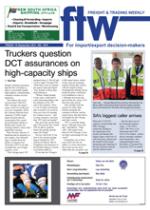A decision by Transnet to place
all terminal operations in the
province under one umbrella has
resulted in the ports becoming much
more integrated into economic
development in the province, says
Siyabulela Mhlaluka, Terminal
Executive Manager Eastern Cape
Terminals.
The strategy was implemented
when Transnet moved away from
centralised management for each of
the terminal operations.
Looking back after a year at the
helm of the division which he has
headed up since it was formed,
Mhlaluka says “much has been
achieved over the past year because
we have been able to focus on the
Eastern Cape as a region. Our ports
are unique, and we have been able to
align our operations and investment
to meet the needs of the region.
“We understand and complement
the role the ports play in ensuring
the success of provincial and local
government economic development
programmes.”
Transnet has also signed a
memorandum of understanding with
the Eastern Cape government to help
develop the province’s economy.
“We are seeing a greater
collaborative spirit between local
government, national government
and Transnet. That is a good thing,”
he says.
Economic development is close to
the heart of Mhlaluka, who is past
president of what is now the Nelson
Mandela Bay Business Chamber
(formerly Percci).
Trading and export-based
economies such as that of the Eastern
Cape are reliant on the efficiencies
of their ports, which are the main
gateways for imports and exports.
Mhlaluka is proud of the Eastern
Cape Terminals team, which
continues to raise the productivity
bar and ensure that there is sufficient
capacity to facilitate trade.
“Starting in East London, we
are experiencing growth in vehicle
volumes, while containers are stable.
“On the bulk side, maize exports
are also growing.
“Moving down the coast,
Ngqura has done wonders for us.
Volumes have exploded beyond our
expectations and the projections of
the shipping lines.
“Our team has responded by
constantly improving productivity. In
July, we averaged 30 moves per gross
crane hour (GCH) – up from 22 when
the port opened. Our target is 32 by
the end of the year.
“The Port Elizabeth container
terminal is doing well despite the
fact that the equipment is due for
replacement. In September operators
reached 28 GCH, and the average is
25 GCH.
“These efficiencies are being
achieved despite adverse weather. In
addition to winds, both ports have
been experiencing unusually strong
currents at the quay walls. Both
ourselves and Transnet National Port
Authority are trying to identify the
cause so that we can take remedial
action.
“In the meantime, one solution
has been to work more carefully and
therefore more slowly to ensure that
work continues safely on the vessels
and delays are kept to a minimum.”
Productivity records are also being
set at the Port Elizabeth car terminal,
with an average handling rate of
200 units an hour during August
– a record month in which 17 445
vehicles were exported and imported
through the port.
Year-on-year, the August to August
vehicle volumes through the port
have grown by 11% (66 539 to
74 239).
Manganese exports are heading
towards the 5.5-million tons-ayear
capacity of the Port Elizabeth
terminal.
Mhlaluka is keen to see capacity
increased in order to cater for the
smaller mining companies. “There
are serious constraints in our ability
to cater for the smaller mines, and
they are having to send ore out by
container through Ngqura,” he says.
EC Ports – gateways to opportunity
16 Sep 2011 - by Staff reporter
0 Comments
FTW - 16 Sep 11

16 Sep 2011
16 Sep 2011
16 Sep 2011
16 Sep 2011
16 Sep 2011
16 Sep 2011
16 Sep 2011
16 Sep 2011
16 Sep 2011
Border Beat
Poll
Featured Jobs
New
